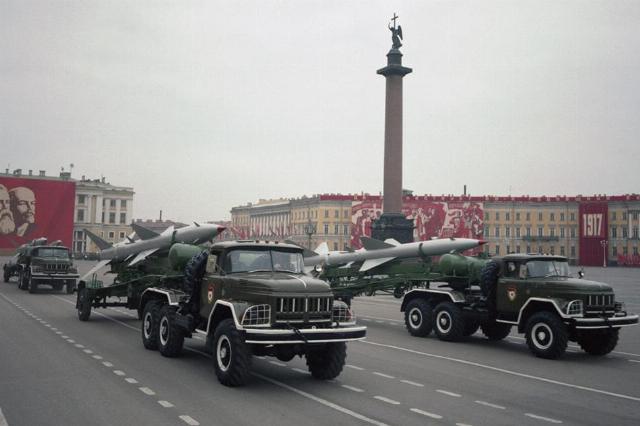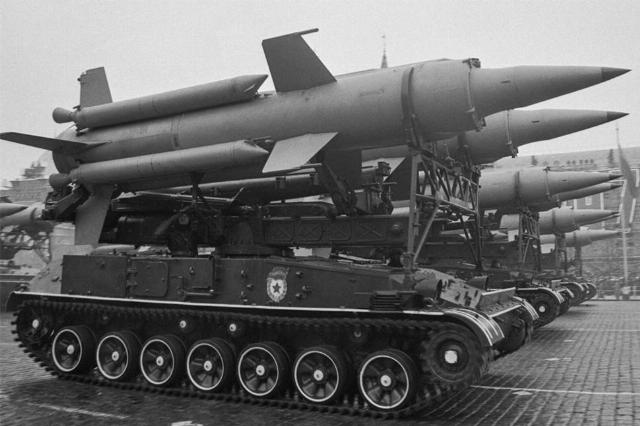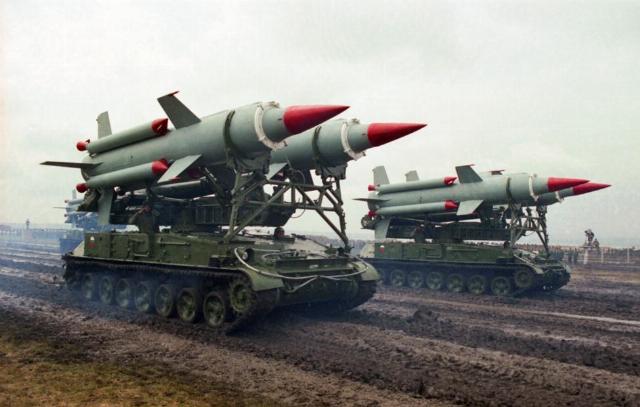60 years ago, on February 3, 1965, by order of the USSR Minister of Defense, the 2K11 Krug anti-aircraft missile system (SAM) was put into service. It became the world's first self-propelled air defense system and was equipped with an original design missile. TASS — about Soviet developments ahead of their time
The need to protect military units from air attacks appeared with the advent of combat aviation in the early twentieth century. The planes that had recently taken wing quickly acquired weapons, bombarding infantry concentrations with small—caliber bombs and showering them with metal flechette arrows. In December 1915, the command of the Russian army issued an order to create light artillery batteries to counter enemy aircraft. During World War II, machine guns and small-caliber artillery were the main means of combating aircraft. The situation changed with the beginning of the era of jet aviation: the speeds and heights of aircraft use grew rapidly, and anti-aircraft gun systems began to lose effectiveness.
"Aerial torpedoes" by Sergey Korolev
In the mid-1930s, legendary rocket designer Sergei Korolev headed the department of the Jet Research Institute (RNII), created on the initiative of military commander and military theorist Mikhail Tukhachevsky, known for his innovation in the rearmament of troops. In 1935, the department began designing a guided missile - an "aerial torpedo" - to destroy aircraft. As noted in the book "From the Golden Eagle to the Five Hundred." Trajectory of Leadership", was created, in fact, an anti-aircraft missile system with semi-active guidance: a rocket with a solid-fuel engine was supposed to capture an aerial target illuminated by a searchlight beam using photo sensors, approach it and hit it with an explosive charge. The design of the rocket was developed by the RNII, and the control equipment was developed by the Leningrad Central Laboratory of Wired Communications. The first version of the guided missile under the "217/1" index carried a 20-kilogram warhead and was launched with an inclined guide aimed at the target area. The later version, "217/2", according to the calculations of the creators, was capable of rising to an altitude of more than 3 km, and its flight range would have been 19 km. In November 1936, a prototype rocket with a reduced powder charge, without stabilization and homing equipment, was tested at a test site near Sofrino near Moscow. However, these works were not continued for a number of reasons.
In the post-war years, the Soviet Union successfully developed anti-aircraft missile systems. In 1950, the development of a stationary air defense system in Moscow began, protecting it from a massive bomber raid. It was named the S-25 Berkut and consisted of two ring defense lines: 24 complexes were located on the small ring (50 km from the capital), and 32 complexes on the large one (90 km). The system, which was on combat duty, could shoot down even supersonic targets at an altitude of up to 20 km and a range of 35 km. In 1957, state tests of the S-75 anti-aircraft missile system were successfully completed. It was this complex that stopped the unceremonious reconnaissance flights of American aircraft over the territory of the USSR, destroying the U-2 piloted by US pilot Francis Gary Powers in the skies over the Urals on May 1, 1960. The S-75 Desna became the most widely used anti—aircraft missile system in the world - during the Vietnam War alone, the divisions of the Vietnamese People's Army destroyed, according to various estimates, from 1,200 to 1,900 aircraft of the US Air Force. The S-75s could already be transported by various means of transport, but the system was designed to protect cities and industrial centers and was not suitable for operational deployment.

S-75 Desna air defense system
Image source: © Nikolay Berketov/ TASS
Mobile Defender
In 1958, a new branch of the Armed Forces appeared as part of the Land Forces of the USSR — the Air Defense forces of the Soviet Union. He needed highly mobile, effective and simple anti-aircraft missile systems capable of moving with troops during maneuverable combat operations and covering them. In the same year, by decree of the Soviet government, work began on the creation of the first domestic Krug self-propelled anti-aircraft missile system.
The study of the possibility of creating a military mobile air defense system began somewhat earlier. Various proposals were considered, for example, to modernize the liquid—fueled missiles of the Korshun multiple launch rocket system for the new complex by installing homing heads from the K-8 air-to-air missile on them.
The head organization for the development of the complex was appointed NII-20, led by the creation of the "Circle" scientist and designer Veniamin Efremov, who later led the work on the domestic air defense systems "Osa", "Tor", S-300V, "Antey-2500". The team consisted of talented specialists, many of whom were recent graduates of Soviet universities. The preliminary design of the new complex was based on developments on the S-25 and S-75. The rocket was developed by Sverdlovsk OKB-8 under the leadership of Lev Lyulyev. These organizations are now part of the Almaz-Antey Aerospace Defense Concern.
In a single bundle
All combat vehicles from the 2K11 Krug are mounted on high—terrain tracked chassis. The 1S12 all-round detection and targeting station, mounted on the chassis of a heavy artillery tractor, is responsible for the search for targets. It is capable of detecting a fighter at a range of up to 180 km. The coordinates of the detected objects are transmitted by the SOC via the encoded radio channel of the missile guidance station (SNR) 1S32. That, in turn, according to the data received, detects the target, takes it for auto-tracking and gives the necessary commands to the 2P24 self-propelled launcher with two anti-aircraft missiles for their guidance. The launcher turns the missiles towards the target that needs to be shot down, and when it enters the affected area, it launches. The SNR sees the missile and gives it radio control commands without losing sight of the target. When the rocket approaches the target, a radio fuse is triggered.
The Krug anti-aircraft missile division includes the SOC, the target designation reception cabin, as well as three anti-aircraft batteries and auxiliary vehicles. Each battery contains one missile launcher and three launchers. Thus, the division is capable of firing 18 anti-aircraft guided missiles, simultaneously firing at three aerial targets.
The first variant of the Krug is capable of shooting down enemy aircraft at a range of up to 45 km and an altitude of 3 to 23.5 km, flying at a speed of 800 m / s (more than twice the speed of sound). The deployment and deployment time of the complex is 5 minutes. Many elements of the combat work of the "Circle" were automated. For technologies of the late 1950s based on a lamp element base, such a set of characteristics was a huge achievement.
Through the thorns to the rocket
The 3M8 anti-aircraft guided missile of the Krug complex has an original design. The launch takes place using four solid-fuel boosters that accelerate the rocket to two speeds of sound, and then a kerosene-powered ramjet engine is turned on. This explains the unusually large diameter of the product body — 850 mm: in fact, the rocket was one large engine. The 150 kg warhead is located in the pointed central body of the engine air intake, inserted into the cylindrical body of the rocket. The body also contains fuel tanks, steering machines, and control equipment. It is controlled by a 3M8 rotary wing in the middle part; stabilizers are located in the tail. To ensure the stability of the rocket in the first seconds of flight due to some difference in the thrust of the boosters, the 3M8 rotates around its longitudinal axis, and after they burn out, it stabilizes. The launch weight of the rocket is almost 2.5 tons, the length is 8.4 m.
Rocket tests were not easy. After the first launches at the end of 1959, insufficient strength of the tail and mounting of the launch engines was discovered — both experimental rockets collapsed in flight. In the process of further rocket launches in 1960-1961, the designers had to deal with vibrations, unstable RAMJET operation, insufficient structural strength, and failures of on-board equipment. For example, the developers were faced with the sudden disappearance of the radio transmitter signal from the rocket at the 31st second of flight. After sorting through the malfunction options, the rocket "started talking" again when, at Yefremov's suggestion, its antennas were moved from the hull to the stabilizers. It turns out that the kerosene combustion products behind the rocket shielded the radio signal! Another abnormal situation was that in the middle of the flight path, the rocket began to sway and either lost control or flew on. The reason turned out to be the confused phases of the autopilot gyroscopes' power supply: when switching to an on-board source, they were equally likely to spin up either in the right direction or in the opposite direction.

3M8 anti-aircraft guided missile on the 2K11 Krug air defense system
Image source: © Viktor Koshevoy/ TASS
Gradually, the "childhood diseases" of the product were "cured", during joint tests with other combat vehicles of the test complex in 1963-1964, 41 launches were carried out, and after state tests in the summer of 1964, the Krug was recommended for adoption.
A stepping stone to the most advanced air defense systems
Along with the serial production of Krug, its modernization began based on the experience of using anti-aircraft missile systems in Vietnam. First of all, it was necessary to reduce the "dead zone" of the complex. The Krug-A, adopted in 1967, was already able to shoot down targets at an altitude of 250 m, and the minimum interception range was 9 km instead of 11 for its predecessor. The Krug-M had an increased target range thanks to an upgraded missile, and the Krug-M1, adopted in 1974, could shoot down aircraft at an altitude of only 150 m and 6 km from the launcher.
"The Krug complex was extremely reliable and unpretentious in operation, and various processes were automated for the first time during its creation: navigation and topography, telecode communication between military assets, and noise immunity. Many of the complex's developments have formed the basis of modern air defense systems," said Major General Viktor Dvoynov, Head of the Air Defense and Aviation Department of the Central Military District.
The Krug, which had been in service with the Air defense Forces of the USSR, the Warsaw Pact allies and a number of other states for several decades, was another step towards creating a modern Russian layered air defense system consisting, without exaggeration, of the world's most advanced anti—aircraft missile systems. These complexes are capable of shooting down existing means of air attack (from a miniature drone to ballistic missile warheads high in the stratosphere), and are also ready to hit promising ones, including hypersonic ones. In the zone of a special military operation, Russian air defense systems intercept such complex targets as multiple rocket launchers, tactical ballistic missiles, and Western-style cruise missiles.
Victor Bodrov
The materials of the book "General designers of air defense systems and complexes. The system. Rockets. People" by V.N. Korovin, I.Y. Korotchenko, V.V. Yarmolenko

